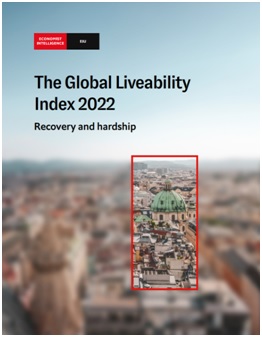

|
Overview
|
Context
The European Intelligence Unit (EUI) recently released the Global Liveability Index 2022.
Background
- Since last year, the average liveability index has significantly improved, reflecting improvements in healthcare, education, and culture across most cities as a result of the removal of COVID-related restrictions.
- The score, however, is still below pre-pandemic levels as a result of the deterioration of stability in several eastern European towns as a result of Russia's invasion of Ukraine.
- As scores for culture and environment, education, and healthcare increase globally, the average index has recovered to 73.6 (out of 100), up from 69.1 a year ago.
- The index, nevertheless, is still below the pre-pandemic average of 75.9, which was recorded.

Analysis
Parameters of the Index
- It ranked 173 cities on the basis of their liveability or living conditions.
- When ranking, out of the five factors, the EUI attaches the highest weightage to stability and culture and environment. Summing all accounts for 25% each.
- It is followed by Healthcare and infrastructure with 20% each and Education with 10%.
- The list, for the first time, included five Indian cities; Delhi, Mumbai, Chennai, Ahmedabad, and Bangalore.
- Rank of Indian Cities: All five scored poorly, ranked between 140 and 146.
- Delhi: 140
- Mumbai: 141
- Chennai: 142
- Ahmedabad: 143
- Bangalore: 146
Key findings
- Bangalore received a score of 46.4, out of 100, in infrastructure.
- Pakistan’s largest city Karachi was one of the five least livable cities in the world in the index, but it has still scored better than Bangalore in terms of infrastructure.
- The infrastructure score is based on the quality of roads, public transportation system, international links, energy provision, telecommunications, water, and availability of good quality housing.
- The most livable city according to the index is Vienna.
- The Syrian capital, Damascus is the least livable city in the world.
- Kiev (Ukraine) had to be left out of the poll, and Moscow and St. Petersburg (Russia) suffered a decline in rankings.
What are the reasons for India’s weak performance?
- According to the index, the major reason evaluated is Lack of proper Infrastructure in major cities.
- Road Connectivity
- Public transportation system
- Energy provision
- Telecommunications
- Water and Sanitation
- Availability of Housing Infrastructure
Challenges associated
- Revenue Shortfall: Slippage in revenue estimates may not be ruled out on account of the realization of lower than anticipated increases in nominal GDP growth, direct tax buoyancy, and disinvestment targets.
- Lesser Funds with States: The Union government has accepted the 15th Finance Commission report recommendation, according to which vertical share of tax devolution from the center to states has been reduced 42% to 41%.
- Moreover, the central government increasingly resort to the imposition of cesses which are almost permanent have reduced the shareable pool.
- Issues Associated With Burgeoning Fiscal Deficit: Infrastructure development in India will be funded by fiscal stimulus.
- However, the rising fiscal deficit can cause macro-economic stability issues like high inflation, crowding out, a downgrade of international ratings, etc.
- Issues Associated With Bad Bank: Finding buyers for bad assets in a pandemic hit economy will be a challenge, especially when governments are facing the issue of containing the fiscal deficit.
- Also, the bad bank idea is like shifting loans from one government pocket (the public sector banks) to another (the bad bank).
- Structural Problems: Due to land acquisition delays and litigation issues, the rate of implementation of projects is very slow on global standards.
- Further, getting approvals are very difficult in terms of land access, environmental clearances; impending litigation in court delays the infrastructure projects.
What more can be done?
- Road infrastructure and connectivity needs to be improved.
- Technological integrated traffic management system.
- Waste management system should improve.
- Waste water system must be improved to secure safe drinking water.
- Housing infrastructure with and urban planning needs focus upon.
- Urban planning and disaster resilient infrastructure model for urbanization.
|
Important Government Initiatives focusing on infrastructure
|

